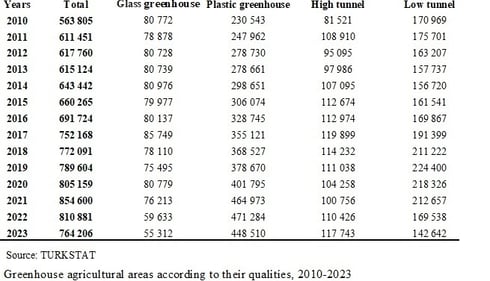Greenhouse Farming: Innovating Sustainable Agriculture
Discover how greenhouse farming is revolutionizing global agriculture. From smart greenhouses in Spain to geothermal innovations in Türkiye, learn how these advancements address food shortages and promote sustainable crop cultivation across diverse climates. Embrace the future of agriculture today!
RURAL INNOVATION
Mithat Direk
9/28/2024


One of the most significant benefits of greenhouse farming is its ability to provide a controlled environment that allows plants to thrive in areas experiencing extreme weather conditions. In contrast to traditional farming, where crops are subject to the unpredictability of outdoor environments, greenhouse farming ensures that plants are protected from harsh elements and can grow in optimal conditions. Greenhouse farming is no longer just about protecting crops from cold temperatures. It has evolved into a sophisticated agricultural technique where factors like humidity, temperature, and light can be adjusted to suit the specific needs of each plant. As such, greenhouses hold the potential to address the world's growing food demand, making them indispensable in ensuring global food security.


A Personal Encounter with the Power of Greenhouse Farming
My firsthand experience with the potential of greenhouses occurred during a visit to the Chicago Botanical Garden in the United States. I was amazed to see orchids flourishing in a tropical greenhouse environment, even though the orchids were far from their natural habitat. This experience demonstrated the remarkable ability of greenhouses to replicate specific climates and grow plants that would otherwise struggle in local conditions. Similarly, in Türkiye, the Konya Tropical Butterfly Garden offers a similar experience, showcasing the advancements and capabilities of modern greenhouses. These examples underscore the vital role that greenhouses can play in supporting diverse plant growth.
European Greenhouses: A Model for the Future
Europe, particularly Spain, offers key insights into the future of greenhouse farming. The city of Almeria is home to vast "smart" greenhouses, which use cutting-edge technology to maximize efficiency and productivity. These greenhouses monitor internal environments using automated systems, ensuring that crops receive the optimal growing conditions. This approach represents the future of agriculture, where technology and sustainability are at the forefront of greenhouse operations. Smart greenhouses exemplify how technological advancements can help solve food supply challenges in an economically viable way.
Greenhouse Farming in Türkiye: Untapped Potential
Türkiye has tremendous potential for greenhouse farming, thanks to its favorable climate and geographic conditions. However, much of the country's greenhouse sector still focuses on traditional methods, such as protecting crops from cold weather, rather than embracing modern, controlled-atmosphere greenhouses. For Türkiye to realize the full potential of greenhouse farming, the sector requires significant restructuring. Investments in new technologies, government support, and education for farmers are essential for moving toward a more advanced and sustainable greenhouse industry.
The Growth of Greenhouse Assets in Türkiye
When examining the state of greenhouse assets in Türkiye, the data reveal substantial growth over the past decade. Greenhouse assets in the country have increased by 35%, with high tunnels playing a significant role in this expansion. On the other hand, the presence of glass greenhouses has decreased, while plastic-covered greenhouses have surged by 95%, indicating a shift toward more cost-effective structures. Although these trends are promising, there are still challenges to be addressed, particularly regarding the development of atmosphere-controlled greenhouses, which are vital for long-term sustainability and profitability.


Economic Feasibility and Crop Selection
One of the biggest challenges to expanding atmosphere-controlled greenhouses is the high initial investment required. Whether or not a farmer invests in such a system depends on the balance between production costs and the potential revenue from selling the crops. In Türkiye, more than 50% of greenhouse production is focused on tomatoes, a crop that is well-suited to greenhouse conditions and has a strong demand in local and international markets. However, there is also significant potential for other high-value crops, such as flowers, which thrive in controlled environments.
The Potential of Flower Cultivation in Greenhouses
Greenhouse farming is not limited to food production. Flowers are another valuable crop that requires high humidity and temperature levels, conditions that can be precisely controlled in a greenhouse. However, Türkiye remains heavily reliant on flower imports due to limited domestic production and consumption. Increasing the local production of flowers could reduce dependency on imports and make greenhouse farming more economically sustainable in the long run. Moreover, growing high-value crops like flowers could help greenhouse operators cover the higher costs associated with controlled-environment farming.
Overcoming Challenges: Technological Advancements and Modernization
Despite the challenges faced by the greenhouse sector, the outlook for its future in Türkiye is promising. Technological advancements are being quickly adopted by both farmers and investors, and there is growing recognition of the need to modernize the sector. A prime example is the development of geothermal greenhouses in Ağrı Diyadin, which are designed to leverage the region’s natural geothermal resources. These greenhouses enable the cultivation of crops like tomatoes year-round, demonstrating the potential of greenhouse farming in even the coldest regions of the country.
The Role of Technology Fairs in Greenhouse Development
One of the key indicators of the greenhouse sector's growth is the increasing popularity of technology fairs, such as GROWTECH. These fairs showcase the latest innovations in greenhouse technology and offer farmers and investors a glimpse into the future of greenhouse farming. As more advanced systems are introduced, the need for modernization becomes even more apparent. Outdated methods, such as nylon-covered greenhouses, should be replaced with modern, atmosphere-controlled systems that can support a wide range of crops.
Shifting Consumer Perceptions of Greenhouse-Grown Products
Another important factor in the success of greenhouse farming is consumer perception. Many consumers mistakenly believe that greenhouse-grown products are harmful to health due to the controlled environment in which they are grown. However, products cultivated in greenhouses are often healthier than their outdoor-grown counterparts because they are subject to stricter monitoring and fewer harmful pesticides. Educating consumers about the benefits of greenhouse-grown produce will help increase demand and ensure the sector’s continued growth.
The Future of Greenhouse Farming: A Path Forward
The future of greenhouse farming holds great promise, both in Türkiye and around the world. By investing in modern technologies and focusing on high-value crops, greenhouse operators can increase their profitability while contributing to global food security. The expansion of controlled-environment greenhouses will be crucial to meeting the challenges of climate change, population growth, and food shortages.
In conclusion, greenhouse farming offers a powerful solution to the challenges facing global agriculture. Whether through the implementation of smart greenhouses in Spain, the development of geothermal greenhouses in Türkiye, or the modernization of state-supported projects, the sector is rapidly evolving. Greenhouse farming is not only a response to food shortages but also a way to sustainably cultivate crops in diverse climates and conditions. As the sector continues to grow and innovate, it will play a vital role in shaping the future of agriculture. Embracing these changes and investing in the development of greenhouses will ensure a more secure, sustainable, and profitable agricultural industry for future generations.
Please note that the views expressed in this article are of the author and do not necessarily reflect the views or policies of any organization.
Mithat Direk is serving the Department of Agricultural Economics, Selcuk University, Konya-Türkiye.
Related Stories
Reframe your inbox
Subscribe to our newsletter and never miss a story.
We care about your data in our privacy policy.
"The Agricultural Economist," your essential weekly guide to the latest trends, research, and insights in the world of agriculture and economics.
The Agricultural Economist © 2024
Published by The AgEcon Frontiers (TAEF)
All rights of 'The Agricultural Economist' are reserved with TAEF
